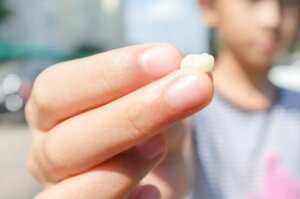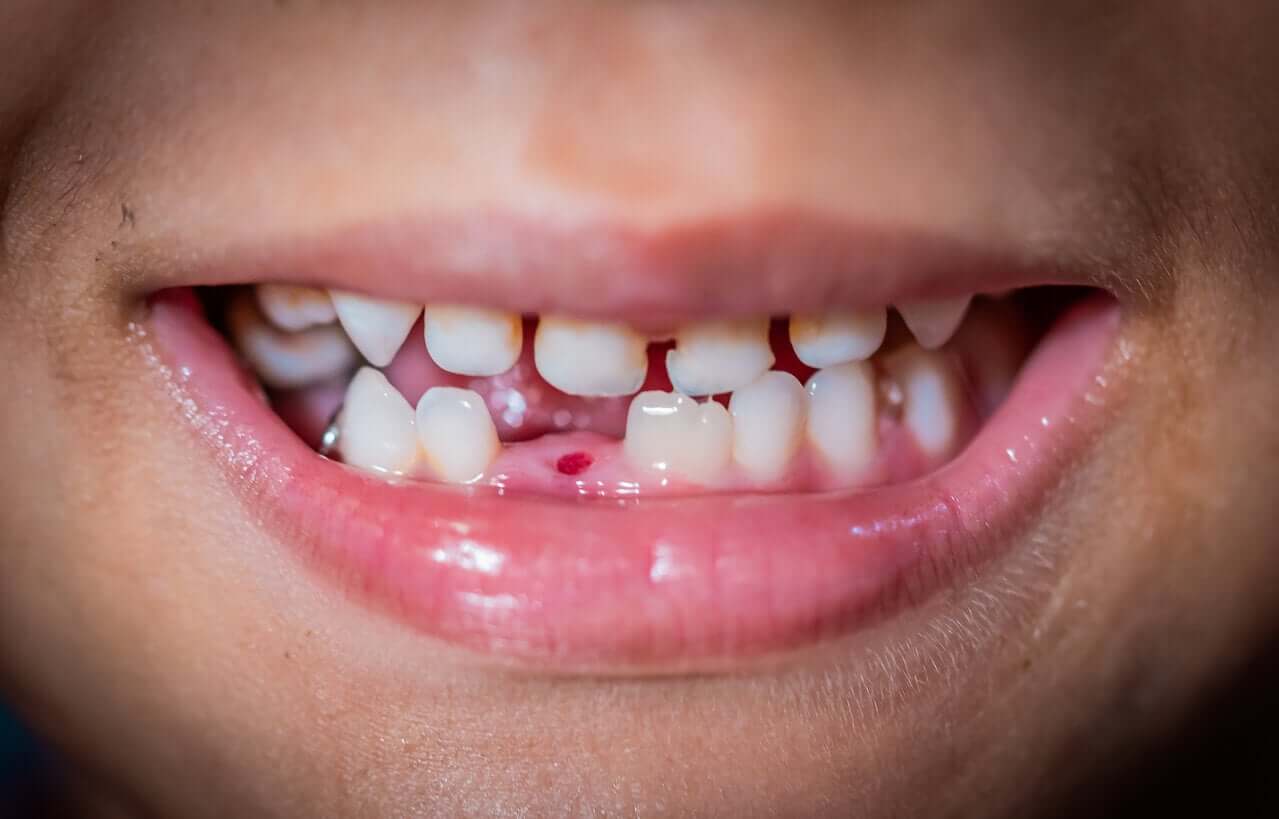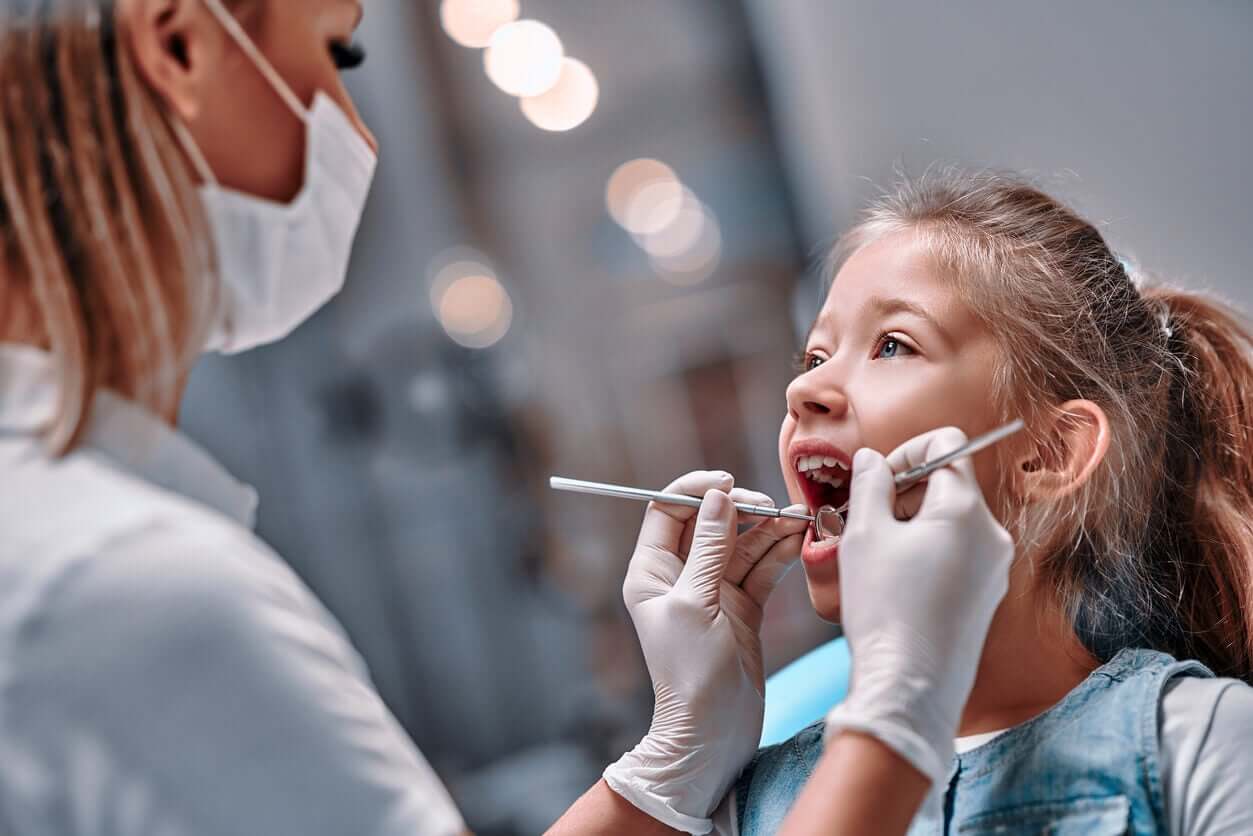Is it Possible to Reimplant a Baby Tooth?

Today, we’ll tell you if it’s possible to reimplant a baby tooth when it comes out as a result of trauma. Keep reading to find out.
When children play or do sports, accidents can occur that affect the oral cavity. The loss of a tooth is a concrete possibility and at that moment of crisis, many parents wonder if they should reimplant a baby tooth that has come out.
Knowing how to act in these situations is essential in order to be able to manage the stress and tension of the event as calmly as possible. Therefore, in this article, we’ll tell you what to do when faced with the premature loss of a baby tooth.
What is the reimplantation of a tooth?
During sports activities or children’s games, falls or accidents can occur that cause trauma to the mouth. As a result of the blow, dental avulsion often occurs, which is the complete exit of the tooth from its socket.
As the tooth is lost, the fibers of the periodontal ligament that support it also break. In addition, there’s a destruction of the vascular and nervous package that irrigates and gives sensitivity to this element.
In some cases, tooth loss can be resolved with reimplantation. This dental treatment consists of repositioning the tooth inside its socket, in order to try to recover the ligamentous fibers and hold it back in place.
But tooth reimplantation isn’t indicated in all cases of avulsion, as in some situations, this isn’t possible to specify.

Is it possible to reimplant a baby tooth?
The loss of a temporary tooth (or baby tooth) due to a blow generates aesthetic and functional problems in the child. It’s very common for these avulsions to occur in the upper central incisors, which makes the absence of the tooth very noticeable.
In addition to the aesthetic factor, the child’s phonation and swallowing are also affected. This is because baby teeth are very important for the development of the final teeth, which haven’t yet completed their maturity and remain inside the bone. Therefore, the conditioning of these oral functions becomes chronic.
As we anticipated, it’s not always possible to reimplant a baby tooth. One of the determining factors is the time between departure and the moment of relocation, as to guarantee the success of the procedure, it’s essential to act quickly.
It may also happen that the dentist considers this therapy to be inadequate for that particular clinical case. Generally speaking, when avulsion occurs in temporary dentition, dentists prefer not to reimplant a baby tooth.
Sometimes, this procedure can damage the final piece in formation, and in the face of this risk, professionals always prioritize taking care of the permanent tooth.
When a baby tooth comes out, the age of the child and the possible date of the eruption of the definitive element should be considered in order to plan an appropriate course of action. The placement of a prosthesis that accompanies the maxillary growth or a device that maintains the empty space are some of the options.
This way, the other dental elements are prevented from moving to take their place. This could cause the definitive tooth to run out of space to erupt and consequently, dental malpositions and bite problems could develop.
Even so, it’s important to know that some professionals do consider reimplanting a baby tooth in very specific cases. To perform this procedure they take into account several factors, such as the age of the child and the degree of development of the permanent tooth germ.
What to do if a baby tooth falls out?
The moment a child hits himself, a situation of discomfort and nervousness is generated in everyone present. Knowing what to do is essential to help the little one.
Here are some tips for dealing with this situation knowingly and safely:
- Keep calm: Acting calmly and confidently helps the child to relax. Don’t show nervousness and don’t scold the child for what happened.
- Wash the wound: Carefully, clean the injured area with water and observe the damage. If there’s bleeding in the soft tissues, it must be stopped. This can be accomplished with sustained compression of the lesion with sterile gauze.
- Observe the teeth: Look carefully inside the mouth and observe if a dental element has come out. If you confirm that a tooth has been lost, you should contact the dentist immediately to accompany you in the situation.
- Find the lost element: Although we already told you that reimplanting a baby tooth isn’t ideal or the most frequent thing, look for the lost tooth. With the desperation of the accident, you may not realize that the missing piece is a definitive one. Or, your dentist may consider the option of reinserting the baby tooth.
- Transport the protruding tooth: Once the avulsed tooth has been found, it must be taken from the coronary portion, without touching the root area. Wash it gently under running water and transport it in a glass with distilled water or warm milk.
- Go to the dentist immediately: The child should be taken to see the dentist as soon as possible. The professional will examine the area and take X-rays to assess the damage and choose the best treatment.
A baby tooth should never be reimplanted at home.

Seek professional help
Accidents and falls often can’t be avoided. The loss of a temporary piece means a moment of pain and nervousness for your little one.
In addition, the lack of a tooth in the mouth alters their appearance, the way they eat, and the way they speak. For this reason, although replanting a baby tooth isn’t usually the most advisable option, seeking dental treatment is.
Going to the dentist immediately if your child hits their mouth is essential. A professional is the best person to solve the problems caused by the blow.
Today, we’ll tell you if it’s possible to reimplant a baby tooth when it comes out as a result of trauma. Keep reading to find out.
When children play or do sports, accidents can occur that affect the oral cavity. The loss of a tooth is a concrete possibility and at that moment of crisis, many parents wonder if they should reimplant a baby tooth that has come out.
Knowing how to act in these situations is essential in order to be able to manage the stress and tension of the event as calmly as possible. Therefore, in this article, we’ll tell you what to do when faced with the premature loss of a baby tooth.
What is the reimplantation of a tooth?
During sports activities or children’s games, falls or accidents can occur that cause trauma to the mouth. As a result of the blow, dental avulsion often occurs, which is the complete exit of the tooth from its socket.
As the tooth is lost, the fibers of the periodontal ligament that support it also break. In addition, there’s a destruction of the vascular and nervous package that irrigates and gives sensitivity to this element.
In some cases, tooth loss can be resolved with reimplantation. This dental treatment consists of repositioning the tooth inside its socket, in order to try to recover the ligamentous fibers and hold it back in place.
But tooth reimplantation isn’t indicated in all cases of avulsion, as in some situations, this isn’t possible to specify.

Is it possible to reimplant a baby tooth?
The loss of a temporary tooth (or baby tooth) due to a blow generates aesthetic and functional problems in the child. It’s very common for these avulsions to occur in the upper central incisors, which makes the absence of the tooth very noticeable.
In addition to the aesthetic factor, the child’s phonation and swallowing are also affected. This is because baby teeth are very important for the development of the final teeth, which haven’t yet completed their maturity and remain inside the bone. Therefore, the conditioning of these oral functions becomes chronic.
As we anticipated, it’s not always possible to reimplant a baby tooth. One of the determining factors is the time between departure and the moment of relocation, as to guarantee the success of the procedure, it’s essential to act quickly.
It may also happen that the dentist considers this therapy to be inadequate for that particular clinical case. Generally speaking, when avulsion occurs in temporary dentition, dentists prefer not to reimplant a baby tooth.
Sometimes, this procedure can damage the final piece in formation, and in the face of this risk, professionals always prioritize taking care of the permanent tooth.
When a baby tooth comes out, the age of the child and the possible date of the eruption of the definitive element should be considered in order to plan an appropriate course of action. The placement of a prosthesis that accompanies the maxillary growth or a device that maintains the empty space are some of the options.
This way, the other dental elements are prevented from moving to take their place. This could cause the definitive tooth to run out of space to erupt and consequently, dental malpositions and bite problems could develop.
Even so, it’s important to know that some professionals do consider reimplanting a baby tooth in very specific cases. To perform this procedure they take into account several factors, such as the age of the child and the degree of development of the permanent tooth germ.
What to do if a baby tooth falls out?
The moment a child hits himself, a situation of discomfort and nervousness is generated in everyone present. Knowing what to do is essential to help the little one.
Here are some tips for dealing with this situation knowingly and safely:
- Keep calm: Acting calmly and confidently helps the child to relax. Don’t show nervousness and don’t scold the child for what happened.
- Wash the wound: Carefully, clean the injured area with water and observe the damage. If there’s bleeding in the soft tissues, it must be stopped. This can be accomplished with sustained compression of the lesion with sterile gauze.
- Observe the teeth: Look carefully inside the mouth and observe if a dental element has come out. If you confirm that a tooth has been lost, you should contact the dentist immediately to accompany you in the situation.
- Find the lost element: Although we already told you that reimplanting a baby tooth isn’t ideal or the most frequent thing, look for the lost tooth. With the desperation of the accident, you may not realize that the missing piece is a definitive one. Or, your dentist may consider the option of reinserting the baby tooth.
- Transport the protruding tooth: Once the avulsed tooth has been found, it must be taken from the coronary portion, without touching the root area. Wash it gently under running water and transport it in a glass with distilled water or warm milk.
- Go to the dentist immediately: The child should be taken to see the dentist as soon as possible. The professional will examine the area and take X-rays to assess the damage and choose the best treatment.
A baby tooth should never be reimplanted at home.

Seek professional help
Accidents and falls often can’t be avoided. The loss of a temporary piece means a moment of pain and nervousness for your little one.
In addition, the lack of a tooth in the mouth alters their appearance, the way they eat, and the way they speak. For this reason, although replanting a baby tooth isn’t usually the most advisable option, seeking dental treatment is.
Going to the dentist immediately if your child hits their mouth is essential. A professional is the best person to solve the problems caused by the blow.
All cited sources were thoroughly reviewed by our team to ensure their quality, reliability, currency, and validity. The bibliography of this article was considered reliable and of academic or scientific accuracy.
- Godoy Cifuentes, M. J. (2013). Conocimiento que posee el odontólogo general acerca del manejo de algunas lesiones traumáticas de tejido periodontal-avulsión, concusión, luxación extrusiva y luxación intrusiva-, en las cabeceras departamentales de Quetzaltenango, Escuintla, Cobán y Chiquimula (Doctoral dissertation, Universidad de San Carlos de Guatemala).
- Gustavo, B. P. Á., & Naira, H. TRAUMATISMOS DENTALES.
- Chávez Sarabia, J. C. (2013). Consecuencias de la avulsión en piezas temporales en la edad escolar (Bachelor’s thesis, Universidad de Guayaquil. Facultad Piloto de Odontología).
- Ávila Rivera, C., Cueto Urbina, A., & González Ríos, J. (2012). Caracterización del traumatismo dentoalveolar que afecta a los tejidos de soporte en dientes temporales. International journal of odontostomatology, 6(2), 157-161.
- Barbería, E., Borrell, C., Bravo, N., Silva, C. C., & Maroto, M. (2010). Traumatismos en los dientes temporales. Causan secuelas en los dientes permanentes?.
- Izquierdo, F. G., Mateo, F. N., & Gil, B. G. (2003). Actitud del pediatra de Atención Primaria ante los traumatismos dentoalveolares. Revista Pediatría de Atención Primaria, 5(20), 51-64.
- Cueto Urbina, A., Ávila Rivera, C., & González Ríos, J. (2012). Traumatismos Dentoalveolares que Afectan a las Estructuras de Soporte de los Dientes Temporales y sus Efectos en los Sucesores Definitivos. International journal of odontostomatology, 6(3), 379-383.
- Duarte, L. A. J. (2017). Reimplante Dentario en Diente Avulsionado. Presentación de un Caso. Revista Científica Hallazgos21, 2(3).
- Hernández, H. I., Corona, J. P., Ramírez, M. M., & Luna, J. A. (2012). Exarticulacion (avulsion dental) en denticion temporal y permanente. Reporte de dos casos clinicos. Revista de la Academia Mexicana de Odontología Pediátrica, 24(2), 90-96.
This text is provided for informational purposes only and does not replace consultation with a professional. If in doubt, consult your specialist.








